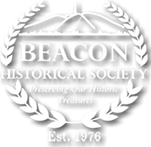Inspiration. Bravery. Perseverance. Character. Democracy: The Life of James F. Brown
James F. Brown was a former manumitted slave who became the master gardener at the Verplanck homestead. As a free African American, he enjoyed an active social and civic life with friends and family in the Hudson Valley and NY City. He was a voter and homeowner. His is best known for writing a ten volume diary from 1829-1866, a chronicle that helps us to understand the early national and antebellum United States. To learn more about Brown, please read Dr. Myra B. Young Armstead’s book Freedom Gardener: James F. Brown, Horticulture, and the Hudson Valley in Antebellum America and visit the Verplanck homestead at the Mount Gulian Historic Site.
James Brown lived at 37 Division Street. His home was approximately 1.5 miles to Mount Gulian. Division Street is now Rombout Avenue.
Brown’s diaries and a biographical sketch was featured in the Fishkill Standard newspaper in 1895. Here is a clipping from a scrapbook in the BHS archives.
The Gardner’s Monthly was one of many horticultural periodicals that started to appear in 1820. This page, from Henry Winthrop Sargent’s 1859 bound collection, is the type of literature Brown would have been familiar with as master gardener. He visited Wodenethe, Sargent’s home on many occasions.
Mount Gulian Historic Site was the original home to the Verplancks. It was here that Brown was the master gardener from 1829 to the 1860s. Visit www.mountgulian.org for more information.
Brown is featured on a colorful 3D sculpture/mural that greets visitors at the Howland Library. Mika Seeger and volunteers from the Beacon Sloop Club created this mural with clay from the Hudson River in 1992. Brown's dignified visage was inspired by the likes of Frederick Douglass, a national leader in the abolitionist movement. Clutching a diary in his left hand, the sculpture is homage to Brown's daily recordings in from 1829-1866. Through his writing, we are able to learn about his life, the Hudson Valley, and antebellum America.
Dr. Armstead examines Brown’s life in context of antebellum America. This is a fascinating history about the Hudson Valley and our nation during this time period.
Brown is buried at St. Luke’s cemetery - 850 Wolcott Avenue, Beacon NY. He is located in the northeastern corner of the lot.







